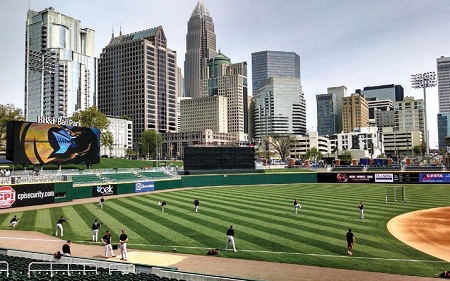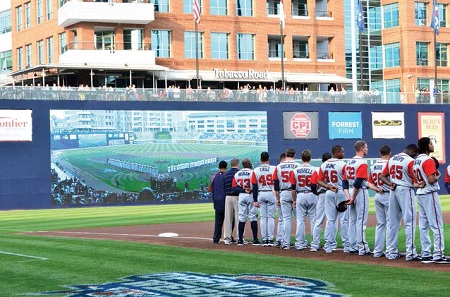Behind the A/V Revolution at Sports Stadiums
SAN FRANCISCO—When it comes to integrating new audio and video technologies into a stadium, the fan experience comes into play more and more. And that demand for more camera angles and slo-mo replays that fans are used to seeing on their home TV screens is impacting the design of even bigger screens at the stadiums.
Particularly in a sports environment, the technology in front of the audience and behind the scenes have to work seamlessly hand in hand.
Systems integrators have taken that notion to heart. Over the last several years, companies like TSE Services in Scottsdale, Ariz., have devoted much of their audio/video services integration to sporting environments, from minor league ballparks to major league soccer stadiums.

To enhance the ballpark experience for fans of the Charlotte (N.C.) Knights, TSE partnered with Toshiba Managed Business Services to install one of Minor League Baseball’s most spacious and brightest scoreboards at the team’s home BB&T Ballpark.SOUTHERN EXPOSURE
Most recently, the company finished up two sports install efforts in the south, with audio and video installs at WesBanco Arena, home of the ice hockey team the Wheeling Nailers in West Virginia as well as a Minor League baseball park—Joseph P. Riley, Jr. Park—that hosts the Charleston RiverDogs in South Carolina.
The goal of both of those audio and video installations was to enhance the fan experience, TSE said.
The Nailers project in West Virginia was centralized around the addition of new digital ribbon boards and a high-definition center- mounted video board. Partnering with Cincinnati-based landscape lighting manufacturer LSI Industries, TSE was responsible for designing, relocating and installing a new high-definition production room to support the new displays. Technology included a NewTek TriCaster 860 video switcher and NewTek 3Play for instant replays and wireless fan cams.
Likewise, the RiverDogs project in South Carolina was focused on streamlining audio around the ballpark and enhancing the instadium communication and video systems. Audio amplifiers were installed to break the ballpark into multiple digital zones that would allow stadium A/V operators to change the sound level as needed in different locations throughout the ballpark. Technology additions included a Canon XU-81W HD remote PTZ camera in center field, along with new ticket window intercom systems.
Get the TV Tech Newsletter
The professional video industry's #1 source for news, trends and product and tech information. Sign up below.
The goal of the technological investment was to take attendees’ video and audio experience to a new level, according to Jamel Mallad, TSE project manager for the installation.
The common theme for many of today’s sports stadium installations is digital: largescale video boards, digital signage, menu boards, video walls and digital audio. That same focus went into TSE’s designs at stadiums like BB&T Ballpark in Charlotte, N.C. and the Durham Bulls Athletic Park in Durham, N.C.
But sometimes the technology has to take a less obtrusive role when it comes to preserving the atmosphere in a location— whether that’s a modern take on a slick new hockey arena or maintaining the rustic feel of a minor league ballpark in rural Vermont.
That was the case during the revamp of Centennial Field in Burlington, Vt., when TSE was tasked with installing a high-definition video board into an existing wooden structure that resembled an old mining shed far more than a modern billboard. The integrator worked with LSI Industries to install a 27x16-foot video board and integrated a new digital production room with TSE’s GameTime ScriptPRO game management system, a cloud-based event management SaaS solution designed to organize and execute event scripts.

The Durham (N.C.) Bulls Minor League Baseball team contracted with TSE to overhaul the team’s audio-visual system, which included a new HD game operations production room and improved sound system.FIXED VERSUS NON-FIXED
That same level of attention is required whether the game is played in a small stadium or within the big leagues. NEP’s rising prominence in covering major sporting events came from a two-fold happenstance: networks declining to invest in their own proprietary broadcast facilities in the field, and the real-world experience that outside broadcast production companies have continued to gain in sports-specific production.
That’s not to say, of course, that the experts don’t experience a blip from time to time: There is still discussion about what exactly caused a power outage during the World Series Game 1, though it’s been reported that when Fox lost power to its generators, it knocked out the signal from the NEP production truck that was responsible for airing the domestic feed for the World Series coverage.
In addition to herculean efforts to avoid on-air snafus, what defines sports productions is their similarity to one another, said George Hoover, chief technology officer of the NEP Group. In its 31-year history, which began humbly as part of the WNEP-TV in Scranton, Pa., the mobile production company has covered regional baseball, college football, tennis, soccer, ultimate fighting, professional golf and beyond.
“The biggest challenges are that you’re working in the field, and you have to build from scratch,” Hoover said, which can mean diverse challenges such as deploying fiber throughout an older stadium or outfitting HD cameras in locations where there is no connectivity.
“In regularly occurring venues—like basketball and hockey—this isn’t an issue, but for events like golf or NASCAR when there’s not a regular venue, we have to install cabling infrastructure and take it out afterward,” he said. “There’s a lot of logistics,” particularly for those sporting events that depend heavily upon instant replay, like NFL playoff games or the World Series.”
In an entertainment venue like the Grammys, there are multiple musical acts back to back to contend with, which offers its own challenges. But in a sporting event, there are also ancillary elements like large HD screens and scoreboards for playback materials.
During this year’s World Series coverage, NEP employed a larger number of high-speed slow-motion cameras. “When you’re capturing an image at the higher frame rate of 480 fps or 1,000 fps, it gives you the ability to freeze the ball to see if the runner hit the bag first, or if the fly ball was out of bounds,” Hoover said. “[A lot of our current setups] depend on higher-speed replay cameras and specialized POV cameras, like the ESPN goal-line cameras, or cameras on pylons,” he said, noting that NEP has been using Sony HDC- 4300 4K cameras and Vision Research high-speed cameras.
Sports production also has specific requirements when it comes to storage. “When you go to a higher frame rate, you’re storing more material, which means you need larger hard drives,” he said. It also takes longer to play that content back. “In reality you can’t get more than one or two high-speed replays in before [the play starts again].”
BeckTV is one company that has dived into the sports production realm as well, having completed an HD upgrade of a 48-foot expando mobile production truck as well as having designed a large-scale flypack used at the 2014 French Open tennis tournament.
Recently the Austin-Texas-based company completed a significant renovation of the Dr. Pepper Ballpark in Frisco, Texas. Home to the Frisco RoughRiders, a Class AA minor league baseball team, BeckTV provided design and integration work for the ballpark in an effort to enhance the fan experience, including an upgraded sound system and new Daktronics LED displays driven by a new HD video replay control room.
Susan Ashworth is the former editor of TV Technology. In addition to her work covering the broadcast television industry, she has served as editor of two housing finance magazines and written about topics as varied as education, radio, chess, music and sports. Outside of her life as a writer, she recently served as president of a local nonprofit organization supporting girls in baseball.

